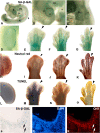Is Senescence-Associated β-Galactosidase a Reliable in vivo Marker of Cellular Senescence During Embryonic Development?
- PMID: 33585480
- PMCID: PMC7876289
- DOI: 10.3389/fcell.2021.623175
Is Senescence-Associated β-Galactosidase a Reliable in vivo Marker of Cellular Senescence During Embryonic Development?
Abstract
During vertebrate embryonic development, cellular senescence occurs at multiple locations. To date, it has been accepted that when there has been induction of senescence in an embryonic tissue, β-galactosidase activity is detectable at a pH as high as 6.0, and this has been extensively used as a marker of cellular senescence in vivo in both whole-mount and cryosections. Such senescence-associated β-galactosidase (SA-β-GAL) labeling appears enhanced in degenerating regions of the vertebrate embryo that are also affected by programmed cell death. In this sense, there is a strong SA-β-GAL signal which overlaps with the pattern of cell death in the interdigital tissue of the developing limbs, and indeed, many of the labeled cells detected go on to subsequently undergo apoptosis. However, it has been reported that β-GAL activity at pH 6.0 is also enhanced in healthy neurons, and some retinal neurons are strongly labeled with this histochemical technique when they begin to differentiate during early embryonic development. These labeled early post-mitotic neurons also express other senescence markers such as p21. Therefore, the reliability of this histochemical technique in studying senescence in cells such as neurons that undergo prolonged and irreversible cell-cycle arrest is questionable because it is also expressed in healthy post-mitotic cells. The identification of new biomarkers of cellular senescence would, in combination with established markers, increase the specificity and efficiency of detecting cellular senescence in embryonic and healthy mature tissues.
Keywords: cell death; cell senescence; development; histochemistry; limb; retina.
Copyright © 2021 de Mera-Rodríguez, Álvarez-Hernán, Gañán, Martín-Partido, Rodríguez-León and Francisco-Morcillo.
Conflict of interest statement
The authors declare that the research was conducted in the absence of any commercial or financial relationships that could be construed as a potential conflict of interest.
Figures





Similar articles
-
Markers of senescence are often associated with neuronal differentiation in the developing sensory systems.Histol Histopathol. 2023 May;38(5):493-502. doi: 10.14670/HH-18-549. Epub 2022 Nov 22. Histol Histopathol. 2023. PMID: 36412998 Review.
-
Senescence-associated β-galactosidase activity in the developing avian retina.Dev Dyn. 2019 Sep;248(9):850-865. doi: 10.1002/dvdy.74. Epub 2019 Jul 1. Dev Dyn. 2019. PMID: 31226225
-
Endogenous pH 6.0 β-Galactosidase Activity Is Linked to Neuronal Differentiation in the Olfactory Epithelium.Cells. 2022 Jan 16;11(2):298. doi: 10.3390/cells11020298. Cells. 2022. PMID: 35053414 Free PMC article.
-
Detection of Senescence Markers During Mammalian Embryonic Development.Methods Mol Biol. 2017;1534:199-210. doi: 10.1007/978-1-4939-6670-7_19. Methods Mol Biol. 2017. PMID: 27812881
-
Aging of the cells: Insight into cellular senescence and detection Methods.Eur J Cell Biol. 2020 Aug;99(6):151108. doi: 10.1016/j.ejcb.2020.151108. Epub 2020 Jul 12. Eur J Cell Biol. 2020. PMID: 32800277 Review.
Cited by
-
Cellular Senescence: Molecular Targets, Biomarkers, and Senolytic Drugs.Int J Mol Sci. 2022 Apr 10;23(8):4168. doi: 10.3390/ijms23084168. Int J Mol Sci. 2022. PMID: 35456986 Free PMC article. Review.
-
Exploiting senescence for the treatment of cancer.Nat Rev Cancer. 2022 Jun;22(6):340-355. doi: 10.1038/s41568-022-00450-9. Epub 2022 Mar 3. Nat Rev Cancer. 2022. PMID: 35241831 Review.
-
Genetic origins, regulators, and biomarkers of cellular senescence.Trends Genet. 2024 Dec;40(12):1018-1031. doi: 10.1016/j.tig.2024.08.007. Epub 2024 Sep 27. Trends Genet. 2024. PMID: 39341687 Review.
-
Markers of senescence are often associated with neuronal differentiation in the developing sensory systems.Histol Histopathol. 2023 May;38(5):493-502. doi: 10.14670/HH-18-549. Epub 2022 Nov 22. Histol Histopathol. 2023. PMID: 36412998 Review.
-
Modeling the Differentiation of Embryonic Limb Chondroprogenitors by Cell Death and Cell Senescence in High Density Micromass Cultures and Their Regulation by FGF Signaling.Cells. 2022 Dec 31;12(1):175. doi: 10.3390/cells12010175. Cells. 2022. PMID: 36611968 Free PMC article.
References
-
- Ahuja S., Ahuja-Jensen P., Johnson L. E., Caffé A. R., Abrahamson M., Ekström P. A. R., et al. (2008). Rd1 mouse retina shows an imbalance in the activity of cysteine protease cathepsins and their endogenous inhibitor cystatin. Investig. Ophthalmol. Vis. Sci. 49 1089–1096. 10.1167/iovs.07-0549 - DOI - PubMed
-
- Álvarez-Hernán G., Andrade J. P., Escarabajal-Blázquez L., Blasco M., Solana-Fajardo J., Martín-Partido G., et al. (2019). Retinal differentiation in syngnathids: comparison in the developmental rate and acquisition of retinal structures in altricial and precocial fish species. Zoomorphology 138 371–385. 10.1007/s00435-019-00447-3 - DOI
Publication types
LinkOut - more resources
Full Text Sources
Other Literature Sources

